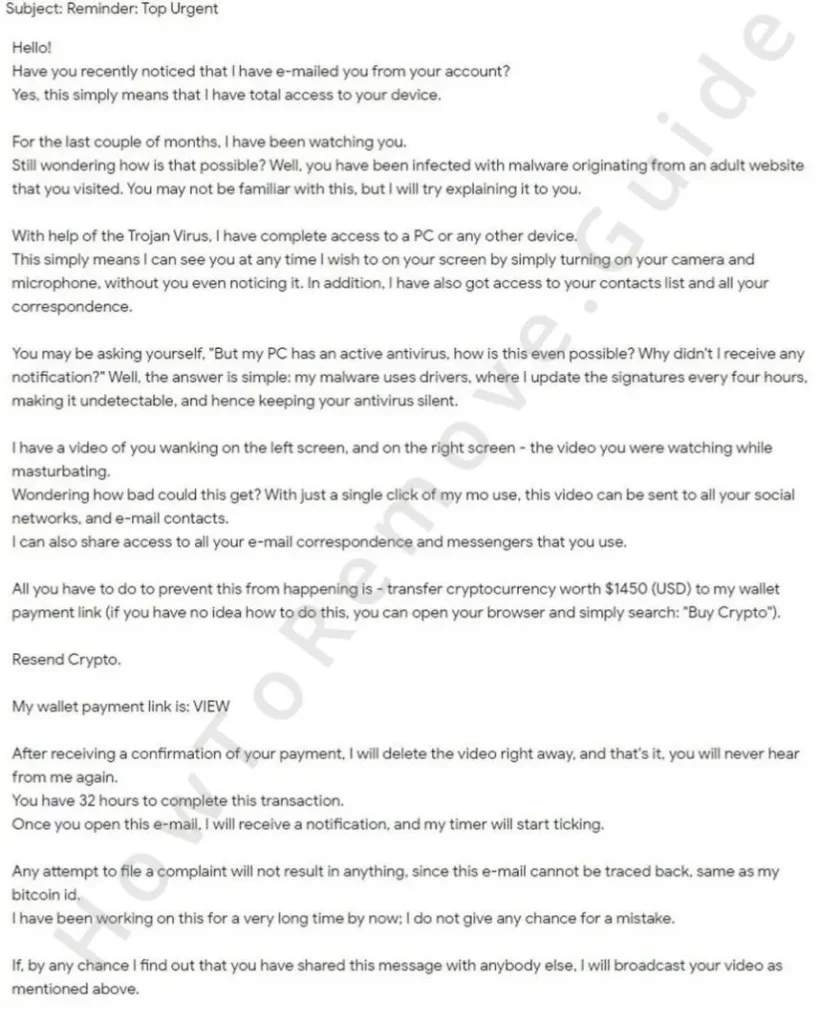If you’ve found your way here, you’re probably concerned about an extortion email you’ve received recently. The sender probably claims they’ve got some images embarrassing images of you and is now threatening to send them to your contacts unless you pay up. I totally get it – such emails can appear terrifying but know this: it’s just a common type of scam, so you almost certainly have no reason to worry.
But I understand if that’s not enough to put your mind at ease, so I invite you to come with me as we further explore the way this scam works. I’ve done a deep dive into this topic to arm you with the knowledge you need to stay safe.

What is the Malware On Porn Website Email Scam?
The Malware On Porn Website Scam is a common type of online fraud also known as “sextortion”. This is how it works most of the time: a cybercriminal claims to have compromising images or videos of you filmed through your web camera while you were visiting a site with adult content on it. The scammer threatens to release the material they supposedly have unless you pay up (Bitcoin is the preferred currency).
What you must understand here is that these claims are almost always bogus. These scammers are master manipulators who prey on fear and embarrassment. They know full well that these emotions can cloud judgment and make the victim act rashly, without thinking.
The email will usually claim that the blackmailer has hacked your device and that’s how they got the footage. To make it more convincing, the scammers will even show you your phone number. This is the thing that gets to most users. Because it’s not surprising that a scammer has your email, but how did they also get the phone number? Maybe they really hacked the device? Nope – there are all sorts of ways a scammer can get to your phone number, so don’t worry if the email includes it.
To make the ruse even more convincing, the email will typically attempt to describe in detail how the scammer supposedly gained access to your device. They might claim they installed malware on a porn site you visited, which then allowed them to record your activities.
They’ll say they captured a split-screen video showing both what you were watching and what your webcam recorded. The technical details are meant to confuse and intimidate you. Don’t let them. Most of the time, when you actually think critically about the supposed mechanism of the malware infection, it becomes blatantly obvious that none of it is real.
Recognizing the Malware On Porn Website Sextortion Emails
If the email you received contains some or all of the following characteristics, it’s almost certainly a scam and you should simply delete it and move on with your life:
Vague Language – The email won’t specify what website you visited or when. It’s all very ambiguous and intentionally so. The vagueness helps them cast a wide net to snag as many victims as possible.
Technical Jargon – The scammers will throw around terms like “keylogger” and “RDP” (Remote Desktop Protocol) to sound convincing but anyone with a bit of actual technical knowledge will quickly realize what’s written there makes zero sense. Even if you’re not tech-savvy, just remember that these terms are used to intimidate you.

Urgency. They’ll always give you a tight deadline – this creates panic and also doesn’t give you any time to think the situation through. The pressure makes you more likely to comply without questioning the legitimacy of the threat.
Bitcoin Payment. Always, always Bitcoin or at least another cryptocurrency. It’s untraceable and fast. The anonymity of Bitcoin makes it the perfect tool for scammers.

Imagine you get an email saying, “I installed malware on a porn site you visited. I have a video of you through your webcam.” They might say they’ll release this to all your contacts unless you pay $1950 in Bitcoin within 24 hours. This creates immediate panic. But take a breath and recognize the signs of a scam.
Another red flag is the claim that they have a special tracking pixel in the email that lets them know when you’ve read it. Tracking pixels can be used to see if an email has been opened. They don’t provide the detailed tracking capabilities these scammers claim. It’s just another scare tactic.
How to Protect Yourself From the Malware On Porn Website Scam
So, how do you protect yourself? What must you do to avoid losing money or getting your virtual privacy invaded? We’ll it down into simple, actionable steps.
- DO NOT PAY OR RESPOND! – Never pay the ransom or reply to the email. Even if the threat is real (which it’s not), you paying the scammers guarantees only one thing – that you’ll lose a bunch of money. There’s nothing stopping them from asking for more. That said, it’s all a bluff on their side, so just don’t pay them and things should be fine.
- Change Passwords – If the email includes a password you’ve used (this is very rare), change it immediately. Use strong, unique passwords for different accounts. Consider a password manager (strongly recommended!) if you’ve got too many online accounts.
- Enable Two-Factor Authentication – Yes, I, too, think its annoying, but it just works and can save you a ton of headache. Even if someone has your password, they can’t get inside your account without a second verification step that they’ll almost certainly have no access to. Two-factor authentication can usually be set up through your account settings and typically involves receiving a code on your phone or using an authentication app.
- Consult Professionals – If you’re really worried, it’s worth having a cybersecurity professional check your devices. They can look for any signs of malware and help secure your system. A professional can provide peace of mind and ensure that your devices are safe.
Taking these steps can significantly reduce your risk of falling victim to sextortion scams. The goal is to protect yourself and make it as difficult as possible for scammers to succeed.
Reporting Sextortion Scams
Sextortion scams like the Malware On Porn Website Scam will probably never end but you can still help fight them by reporting them. Several ways you can do this:
- Email Providers – Report the email as spam or phishing. This helps email providers block similar messages in the future. Most email services have a simple way to report suspicious emails. The best part is that the same sender email can’t target you again.
- Local Authorities – Contact your local police or cybercrime unit. In the U.S., the FBI’s Internet Crime Complaint Center (IC3) is a good resource. Reports help create a record of the scam and can assist in broader investigations.
- Resources and Reporting Tools. – Websites like the FTC’s complaint assistant or Europol’s cybercrime reporting portal are also useful. Here’s a quick link to the FBI’s IC3 for reporting: IC3 Reporting.
We admit that reporting may not always be super effective because scammers can just create a new email and use a VPN to change their IP address. Still, this is a way to make it a bit more difficult for them to harass you and other users.

Leave a Reply